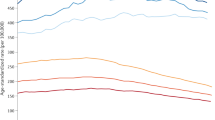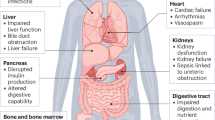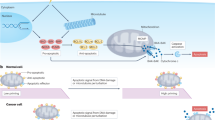Abstract
Mortality that results from the common forms of cancer is still unacceptably high. Despite immense advances in the understanding of the mechanisms of carcinogenesis, in bringing potent new drugs to the clinic and in treating several relatively rare forms of cancer, overall mortality statistics are unlikely to change in a fundamental way until there has been a re-orientation of emphasis in cancer research that will direct greater resources towards prevention of new disease, rather than treatment of end-stage disease.
This is a preview of subscription content, access via your institution
Access options
Subscribe to this journal
Receive 12 print issues and online access
We are sorry, but there is no personal subscription option available for your country.
Buy this article
- Purchase on SpringerLink
- Instant access to full article PDF
Prices may be subject to local taxes which are calculated during checkout



Similar content being viewed by others
References
Sporn, M. B. Carcinogenesis and cancer: different perspectives on the same disease. Cancer Res. 51, 6215–6218 (1991).
Chemoprevention Working Group. Prevention of cancer in the next millennium: report of the Chemoprevention Working Group to the American Association for Cancer Research. Cancer Res. 59, 4743–4758 (1999).
O'Shaughnessy, J. A. et al. Treatment and prevention of intraepithelial neoplasia: an important _target for accelerated new agent development. Clin. Cancer Res. 8, 314–346 (2002).
Lippman, S. M. & Hong, W. K. Cancer prevention by delay. Clin. Cancer Res. 8, 305–313 (2002).
The Oxford English Dictionary 2nd edn Vol. XII p. 444 (Clarendon Press, Oxford, 1989).
Pierce, G. B., Shikes, R. & Fink, L. M. Cancer: A Problem of Developmental Biology (Prentice Hall, Englewood Cliffs, New Jersey, 1978).
Mintz, B. & Fleischman, R. A. Teratocarcinomas and other neoplasms as developmental defects in gene expression. Adv. Cancer Res. 34, 211–278 (1981).
Brivanlou, A. H. & Darnell, J. E. Jr. Signal transduction and the control of gene expression. Science 295, 813–818 (2002).
Baylin, S. B., Herman, J. G., Graff, J. R., Vertino, P. M. & Issa, J. P. Alterations in DNA methylation: a fundamental aspect of neoplasia. Adv. Cancer Res. 72, 141–196 (1998).
Robertson, K. D. & Jones, P. A. DNA methylation: past, present and future directions. Carcinogenesis 21, 461–467 (2000).
Marks, P. A. et al. Histone deacetylases and cancer: causes and therapies. Nature Rev. Cancer 1, 194–202 (2001).
Clark, W. H. Jr. The nature of cancer: morphogenesis and progressive (self)-disorganization in neoplastic development and progression. Acta Oncologica 34, 3–21 (1995).
Bissell, M. J. & Radisky, D. Putting tumors in context. Nature Rev. Cancer 1, 46–54 (2001).
Liotta, L. A. & Kohn, E. C. The microenvironment of the tumor–host interface. Nature 411, 375–379 (2001).
Hennekens, C. H. et al. Lack of effect of long-term supplementation with β-carotene on the incidence of malignant neoplasms and cardiovascular disease. N. Engl. J. Med. 334, 1145–1149 (1996).
Omenn, G. S. et al. Effects of a combination of β-carotene and vitamin A on lung cancer and cardiovascular disease. N. Engl. J. Med. 334, 1150–1155 (1996).
Kelloff, G. J. Perspectives on cancer chemoprevention research and drug development. Adv. Cancer Res. 78, 199–334 (2000).
Mangelsdorf, D. J. et al. The nuclear receptor superfamily: the second decade. Cell 83, 835–839 (1995).
Katzenellenbogen, B. S. & Katzenellenbogen, J. A. Defining the 'S' in SERMs. Science 295, 2380–2381 (2002).
Fisher, B. et al. Tamoxifen for prevention of breast cancer: report of the National Surgical Adjuvant Breast and Bowel Project P-1 Study. J. Natl Cancer Inst. 90, 1371–1388 (1998).
Jordan, V. C. & Morrow, M. Tamoxifen, raloxifene, and the prevention of breast cancer. Endocr. Rev. 20, 253–278 (1999).
Sporn, M. B., Suh, N. & Mangelsdorf, D. J. Prospects for prevention and treatment of cancer with selective PPAR-γ modulators (SPARMs). Trends Mol. Med. 7, 395–400 (2001).
Cauley, J. A. et al. Continued breast cancer risk reduction in postmenopausal women treated with raloxifene. 4-year results from the MORE trial. Multiple outcomes of raloxifene evalutaion. Breast Cancer Res. Treat. 65, 125–134 (2001).
Suh, N. et al. Arzoxifene, a new selective estrogen receptor modulator for chemoprevention of experimental breast cancer. Cancer Res. 61, 8412–8415 (2001).
Horvath, L. G. et al. Frequent loss of estrogen receptor-β expression in prostate cancer. Cancer Res. 61, 5331–5335 (2001).
Lucia, M. S. et al. Chemopreventive activity of tamoxifen, N-(4-hydroxyphenyl)-retinamide, and the vitamin D analogue Ro24-5531 for androgen-promoted carcinomas of the rat seminal vesicle and prostate. Cancer Res. 55, 5621–5627 (1995).
Campbell-Thompson, M., Lynch, I. J. & Bhardwaj, B. Expression of estrogen receptor (ER) subtypes and ERβ isoforms in colon cancer. Cancer Res. 61, 632–640 (2001).
Chawla, A., Repa, J. J., Evans, R. M. & Mangelsdorf, D. J. Nuclear receptors and lipid physiology: opening the X-files. Science 294, 1866–1870 (2001).
Bischoff, E. D., Gottardis, M. M., Moon, T. E., Heyman, R. A. & Lamph, W. W. Beyond tamoxifen: the retinoid X receptor-selective ligand LGD1069 (TARGRETIN) causes complete regression of mammary carcinoma. Cancer Res. 58, 479–484 (1998).
Wu, K. et al. Suppression of mammary tumorigenesis in transgenic mice by the RXR-selective retinoid, LGD1069. Cancer Epidemiol. Biomarkers Prev. 11, 467–474 (2002).
Jones, G., Strugnell, S. A. & DeLuca, H. F. Current understanding of the molecular actions of vitamin D. Physiol. Rev. 78, 1193–1231 (1998).
Guyton, K. Z., Kensler, T. W. & Posner, G. H. Cancer chemoprevention using natural vitamin D and synthetic analogs. Annu. Rev. Pharmacol. Toxicol. 41, 421–442 (2001).
Martinez, M. E. & Willett, N. S. Calcium, vitamin D, and colorectal cancer: a review of the epidemiologic evidence. Cancer Epidemiol. Biomarkers Prev. 7, 163–168 (1998).
Makishima, M. et al. Vitamin D receptor as a bile acid sensor that detoxifies the colon carcinogen lithocholic acid. Science 296, 1313–1316 (2002).
Yanagisawa, J. et al. Convergence of transforming growth factor-β and vitamin D signaling pathways on SMAD transcriptional coactivators. Science 283, 1317–1321 (1999).
Misteli, T. Protein dynamics: implications for nuclear architecture and gene expression. Science 291, 843–847 (2001).
Reddy, B. S. et al. Chemoprevention of colon cancer by specific cyclooxygenase-2 inhibitor, celecoxib, administered during different stages of carcinogenesis. Cancer Res. 60, 293–297 (2000).
Steinbach, G. et al. The effect of celecoxib, a cyclooxygenase-2 inhibitor, in familial adenomatous polyposis. N. Engl. J. Med. 342, 1946–1952 (2000).
Gupta, R. A. & DuBois, R. N. Colorectal cancer prevention and treatment by inhibition of cyclooxygenase-2. Nature Rev. Cancer 1, 11–21 (2001).
Bharti, A. C. & Aggarwal, B. B. Nuclear factor κB and cancer: its role in prevention and therapy. Biochem. Pharmacol (in the press).
Cameron, E. E., Bachman, K. E., Myohanen, S., Herman, J. G. & Baylin, S. B. Synergy of demethylation and histone deacetylase inhibition in the re-expression of genes silenced in cancer. Nature Genet. 21, 103–107 (1999).
Lantry, L. E. et al. 5-Aza-2′-deoxycytidine is chemopreventive in a 4-(methyl-nitrosamino)-1-(3-pyridyl)-1-butanone-induced primary mouse lung tumor model. Carcinogenesis 20, 343–346 (1999).
Ferrara, F. F. et al. Histone deacetylase-_targeted treatment restores retinoic acid signaling and differentiation in acute myeloid leukemia. Cancer Res. 61, 2–7 (2001).
Widschwendter, M. et al. Methylation and silencing of the retinoic acid receptor-β2 gene in breast cancer. J. Natl Cancer Inst. 92, 826–832 (2000).
Tang, B. et al. Transforming growth factor-β1 is a new form of tumor suppressor with true haploid insufficiency. Nature Med. 4, 802–807 (1998).
Massagué, J., Blain, S. W. & Lo, R. S. TGF-β signaling in growth control, cancer, and heritable disorders. Cell 103, 295–309 (2000).
De Caestecker, M. P., Piek, E. & Roberts, A. B. Role of transforming growth factor-β signaling in cancer. J. Natl Cancer Inst. 92, 1388–1402 (2000).
Derynck, R., Akhurst, R. J. & Balmain, A. TGF-β signaling in tumor suppression and cancer progression. Nature Genet. 29, 117–129 (2001).
Kim, S. J., Im, Y. H., Markowitz, S. D. & Bang, Y. J. Molecular mechanisms of inactivation of TGF-β receptors during carcinogenesis. Cytokine Growth Factor Rev. 11, 159–168 (2000).
Chen, T. et al. Transforming growth factor-β receptor type I gene is frequently mutated in ovarian carcinomas. Cancer Res. 61, 4679–4682 (2001).
Fiocchi, C. TGF-β/Smad signaling defects in inflammatory bowel disease: mechanisms and possible novel therapies for chronic inflammation. J. Clin. Invest. 108, 523–526 (2001).
Monteleone, G. et al. Blocking Smad7 restores TGF-β1 signaling in chronic inflammatory bowel disease. J. Clin. Invest. 108, 601–609 (2001).
Danielsen, A. J. & Maihle, N. J. The EGF/ErbB receptor family and apoptosis. Growth Factors 20, 1–15 (2002).
Raben, D., Helfrich, B. A., Chan, D., Johnson, G. & Bunn, P. A. Jr. ZD1839, a selective epidermal growth factor receptor tyrosine kinase inhibitor, alone and in combination with radiation and chemotherapy as a new therapeutic strategy in non-small cell lung cancer. Semin. Oncol. 29, S37–S46 (2002).
Karin, M., Cao, Y., Greten, F. R. & Li, Z. W. NF-κB in cancer: from innocent bystander to major culprit. Nature Rev Cancer 2, 301–310 (2002). | PubMed|
Bromberg, J. & Darnell, J. E. The role of STATs in transcriptional control and their impact on cellular function. Oncogene 19, 2468–2473 (2000).
Turkson, J. & Jove, R. STAT proteins: novel molecular _targets for cancer drug discovery. Oncogene 19, 6613–6626 (2000).
Malumbres, M. & Barbacid, M. To cycle or not to cycle: a critical decision in cancer. Nature Rev. Cancer 1, 222–231 (2001).
Teicher, B. A. (ed.) Tumor Models in Cancer Research. 690 (Humana, Totowa, New Jersey, 2002).
Hong, W. K., Lippman, S. M., Hittleman, W. N. & Lotan, R. Retinoid chemoprevention of aerodigestive cancer: from basic research to the clinic. Clin. Cancer Res. 1, 677–686 (1995).
Sporn, M. B. Hobson's choice and the need for combinations of new agents for the prevention and treatment of breast cancer. J. Natl Cancer Inst. 94, 242–243 (2002).
Song, C. Z., Tian, X. & Gelehrter, T. D. Glucocorticoid receptor inhibits transforming growth factor-β signaling by directly _targeting the transcriptional activation function of Smad3. Proc. Natl Acad. Sci. 96, 11776–11781 (1999).
Matsuda, T., Yamamoto, T., Muraguchi, A. & Saatcioglu, F. Cross-talk between transforming growth factor-β and estrogen receptor signaling through Smad3. J. Biol. Chem. 276, 42908–42914 (2001).
Chipuk, J. E. et al. The androgen receptor represses transforming growth factor-β signaling through interaction with Smad3. J. Biol. Chem. 277, 1240–1248 (2002).
Kang, H. Y. et al. From transforming growth factor-β signaling to androgen action: identification of Smad3 as an androgen receptor coregulator in prostate cancer cells. Proc. Natl Acad. Sci. 98, 3018–3023 (2001).
Fu, M. et al. Peroxisome proliferator-activated receptor-γ inhibits transforming growth factor-β-induced connective tissue growth factor expression in human aortic smooth muscle cells by interfering with Smad3. J. Biol. Chem. 276, 45888–45894 (2001).
Ulloa, L., Doody, J. & Massague, J. Inhibition of transforming growth factor-beta/SMAD signalling by the interferon-γ/STAT pathway. Nature 397, 710–713 (1999).
Bitzer, M. et al. A mechanism of suppression of TGF-β/SMAD signaling by NF-κB/RelA. Genes Dev. 14, 187–197 (2000).
American Cancer Society. Estimated Cancer Deaths and New Cases by Sex and Site: 1971 Cancer Facts and Figures (American Cancer Society, New York, 1970).
Jemal, A., Thomas, A., Murray, T. & Thun, M. Cancer Statistics 2002. CA Cancer J. Clin. 52, 23–47 2002).
Acknowledgements
We thank M. Padgett for expert assistance in the preparation of the manuscript. Our research is supported by grants from the National Cancer Institute, the Department of Defense, the National Foundation for Cancer Research, and the Oliver and Jennie Donaldson Trust. M. B. S is an Oscar M. Cohn Professor.
Author information
Authors and Affiliations
Related links
Rights and permissions
About this article
Cite this article
Sporn, M., Suh, N. Chemoprevention: an essential approach to controlling cancer. Nat Rev Cancer 2, 537–543 (2002). https://doi.org/10.1038/nrc844
Issue Date:
DOI: https://doi.org/10.1038/nrc844



